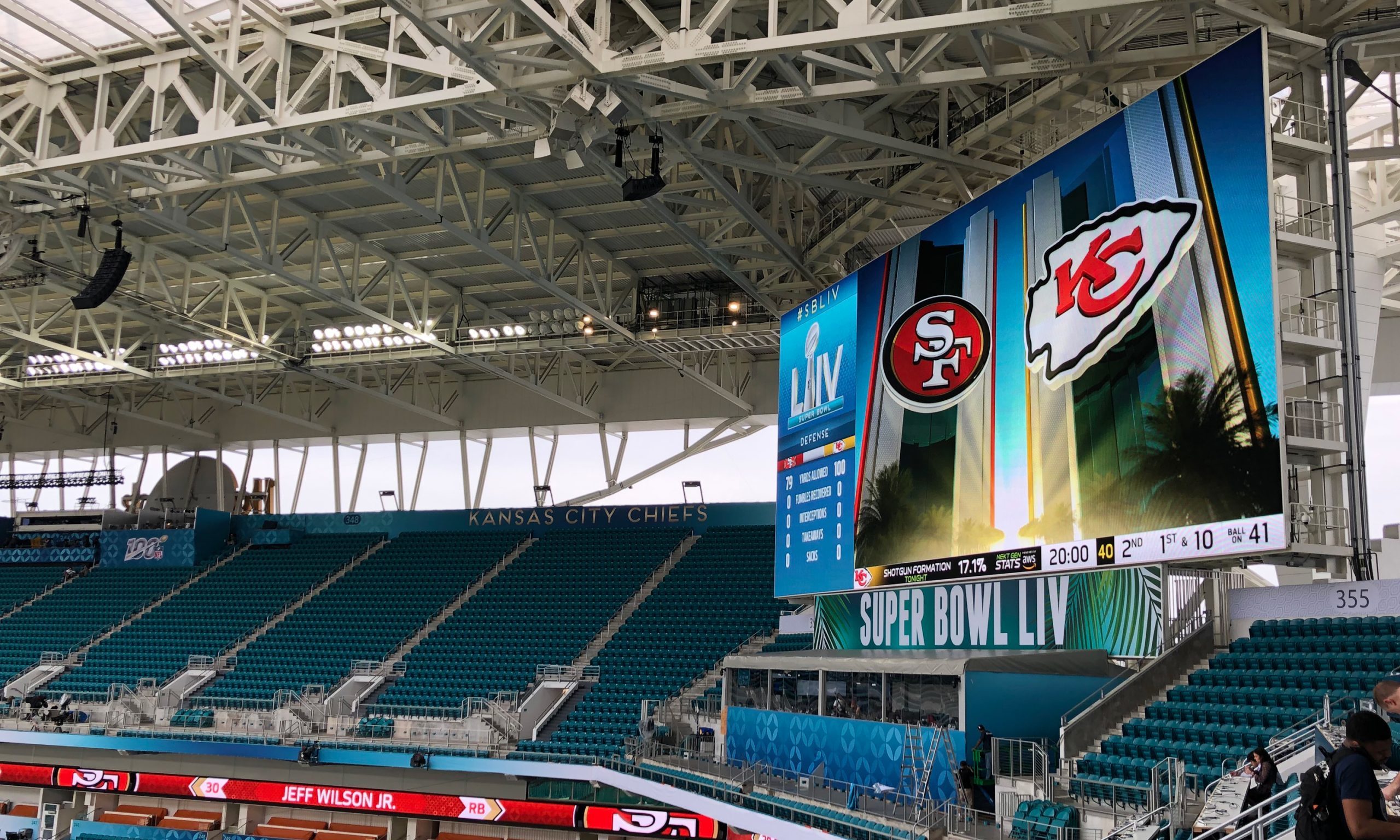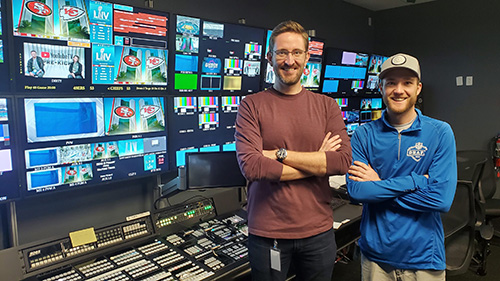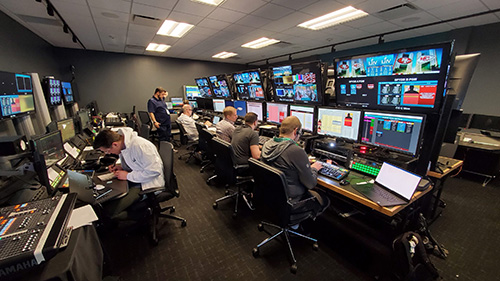Live From Super Bowl LIV: Van Wagner Sports & Entertainment, Hard Rock Stadium Team Up To Produce the Crown Jewel of In-Stadium Shows February 7, 2020

Four videoboards and three ribbons from Daktronics anchor the sharp presentation for fans.
Putting the cap on the celebration of its 100th season, the NFL will acknowledge its past on Super Bowl Sunday at Hard Rock Stadium in Miami by honoring its 100 greatest players. It promises to be a true reflection of just how far America’s favorite sport has come. As far as the Super Bowl itself? As an event to attend as a fan, it’s nothing like it was in those early days. Look no further than the stadium’s videoboard show.

Hard Rock Stadium features four primary videoboards, each erected above the corners of the end zones. Each screen measures at roughly 49 ft. high by 111.5 ft wide.
Twenty-five years ago, Bob Becker, SVP, Van Wagner Sports & Entertainment, worked his very first Super Bowl with VWSE, the sports and marketing agency that oversees the in-venue video production of many of the world’s largest neutral-site national and global championship events. How’s this for full circle: that Super Bowl, Super Bowl XXIX, took place in this very building (then named Joe Robbie Stadium), and this year’s NFC representative, the San Francisco 49ers, won their latest championship. When Becker worked that game, he was one of just two VWSE representatives onsite. This year’s VWSE contingent onsite for Super Bowl LIV numbers at least 60 people.
“Our Super Bowl show has grown tenfold even in just the last five years,” says Nathan McCoart, director, technical operations, VWSE. “It’s really a testament to the NFL wanting to continue to push the envelope, to the creative team on our side, the creative team at the NFL, and everyone working together to keep pushing the Super Bowl forward as the best venue presentation of any event in the world every year.”

VWSE’s Ryan Kehn (left) and Nate McCoart are helping oversee the in-venue videoboard production of Super Bowl LIV at Hard Rock Stadium in Miami.
Super Bowl shows have grown so big, in fact, that most NFL venues don’t have the necessary equipment to pull off what VWSE wants to deliver for the league. But why would they? A show the size of the Super Bowl comes around only once a year.
For this year’s iteration, VWSE has brought in a sizable flypack to help fill out the video infrastructure native to the stadium. A whopping 24 cameras will be in the stadium, shooting for the in-venue show — a number that far exceeds a typical game day at Hard Rock. Among the added gear is also an extra Evertz DreamCatcher system. With two of them, the production team is able to dedicate a full DreamCatcher replay device to each of the participating teams.
Naturally, graphics are a huge driver of the show. Ross is here supporting those efforts in a big way. A pair of Acuity panels drive the program feed, traditional CG (character generation) is running on Xpression, and the Xpression Tessera system is driving the main displays.
There’s also going to be a significant augmented-reality deployment that will ride on the Xpression AR system. On the field, selected camera operators will be equipped with Ross’s ACIDCams with Furio robotic heads that will feed real-time data to the control room. VWSE is also using technology from Piero, the sports-analytics–software supplier that Ross acquired last year, to design and execute graphics with deeper statistical analysis.
All these efforts are intended to fill a stadium that boasts four primary videoboards: one in the upper reaches of each corner of each end zone. Each of the Daktronics displays measures approximately 49 ft. high by 111.5 ft wide and features a 13HD pixel layout. In addition, rimming the bowl are three ribbon boards, measuring 3.5 ft. high and up to 2,105 ft. long. The screens are also fairly new, having debuted in 2016 following a privately funded renovation of the building in 2015.

VWSE has brought more than 60 staffers to integrate with and work alongside the in-house crew from Hard Rock Stadium and the Miami Dolphins.
As for the quality of the video feeding the primary videoboards in the bowl, VWSE will be pushing out 1080p imagery. Even though Fox Sports is producing the game in high dynamic range, these videoboards will not be taking that. VWSE is sticking with SDR, but that promises to look sharp and with a tighter pixel edge on the newer screens.
VWSE is also responsible for programming the many LED screens scattered around the exterior of Hard Rock Stadium. Among the numerous screens is a large board on the building’s Fountain Plaza at the south end zone. From that position, VWSE will be hosting a studio-show–style format for much of the pregame, which will serve as the primary content for fans in the bowl prior to pre-kickoff festivities.
“That’s something we’ve wanted to do for a while, and it really made sense to do that here,” says McCoart. “Gates are opening pretty early before we kick off, and we want to get people inside. We want to give them something to do, something to experience, and something to interact with. We’re going to do an [ESPN] College Gameday type of environment out there: get the fans close to the set, interact with them, and get people to that area.”
VWSE’s crew is also partnering with the in-house venue teams from Hard Rock Stadium and the Miami Dolphins. Becker, McCoart, and VWSE Creative Director Ryan Kehn have worked very closely with Tomas Ruiz, director, broadcast services, Miami Dolphins and Hard Rock Stadium, and Heather Pearson, manager, broadcast operations, Miami Dolphins and Hard Rock Stadium, both of whom have helped lead the way in making Sunday’s show possible.
Dolphins and Hard Rock Stadium production personnel who work in the building every Sunday during the regular season are operating all the notable positions, from camera ops to replay ops.
Four videoboards and three ribbons from Daktronics anchor the sharp presentation for fans.
Putting the cap on the celebration of its 100th season, the NFL will acknowledge its past on Super Bowl Sunday at Hard Rock Stadium in Miami by honoring its 100 greatest players. It promises to be a true reflection of just how far America’s favorite sport has come. As far as the Super Bowl itself? As an event to attend as a fan, it’s nothing like it was in those early days. Look no further than the stadium’s videoboard show.

Hard Rock Stadium features four primary videoboards, each erected above the corners of the end zones. Each screen measures at roughly 49 ft. high by 111.5 ft wide.
Twenty-five years ago, Bob Becker, SVP, Van Wagner Sports & Entertainment, worked his very first Super Bowl with VWSE, the sports and marketing agency that oversees the in-venue video production of many of the world’s largest neutral-site national and global championship events. How’s this for full circle: that Super Bowl, Super Bowl XXIX, took place in this very building (then named Joe Robbie Stadium), and this year’s NFC representative, the San Francisco 49ers, won their latest championship. When Becker worked that game, he was one of just two VWSE representatives onsite. This year’s VWSE contingent onsite for Super Bowl LIV numbers at least 60 people.
“Our Super Bowl show has grown tenfold even in just the last five years,” says Nathan McCoart, director, technical operations, VWSE. “It’s really a testament to the NFL wanting to continue to push the envelope, to the creative team on our side, the creative team at the NFL, and everyone working together to keep pushing the Super Bowl forward as the best venue presentation of any event in the world every year.”

VWSE’s Ryan Kehn (left) and Nate McCoart are helping oversee the in-venue videoboard production of Super Bowl LIV at Hard Rock Stadium in Miami.
Super Bowl shows have grown so big, in fact, that most NFL venues don’t have the necessary equipment to pull off what VWSE wants to deliver for the league. But why would they? A show the size of the Super Bowl comes around only once a year.
For this year’s iteration, VWSE has brought in a sizable flypack to help fill out the video infrastructure native to the stadium. A whopping 24 cameras will be in the stadium, shooting for the in-venue show — a number that far exceeds a typical game day at Hard Rock. Among the added gear is also an extra Evertz DreamCatcher system. With two of them, the production team is able to dedicate a full DreamCatcher replay device to each of the participating teams.
Naturally, graphics are a huge driver of the show. Ross is here supporting those efforts in a big way. A pair of Acuity panels drive the program feed, traditional CG (character generation) is running on Xpression, and the Xpression Tessera system is driving the main displays.
There’s also going to be a significant augmented-reality deployment that will ride on the Xpression AR system. On the field, selected camera operators will be equipped with Ross’s ACIDCams with Furio robotic heads that will feed real-time data to the control room. VWSE is also using technology from Piero, the sports-analytics–software supplier that Ross acquired last year, to design and execute graphics with deeper statistical analysis.
All these efforts are intended to fill a stadium that boasts four primary videoboards: one in the upper reaches of each corner of each end zone. Each of the Daktronics displays measures approximately 49 ft. high by 111.5 ft wide and features a 13HD pixel layout. In addition, rimming the bowl are three ribbon boards, measuring 3.5 ft. high and up to 2,105 ft. long. The screens are also fairly new, having debuted in 2016 following a privately funded renovation of the building in 2015.

VWSE has brought more than 60 staffers to integrate with and work alongside the in-house crew from Hard Rock Stadium and the Miami Dolphins.
As for the quality of the video feeding the primary videoboards in the bowl, VWSE will be pushing out 1080p imagery. Even though Fox Sports is producing the game in high dynamic range, these videoboards will not be taking that. VWSE is sticking with SDR, but that promises to look sharp and with a tighter pixel edge on the newer screens.
VWSE is also responsible for programming the many LED screens scattered around the exterior of Hard Rock Stadium. Among the numerous screens is a large board on the building’s Fountain Plaza at the south end zone. From that position, VWSE will be hosting a studio-show–style format for much of the pregame, which will serve as the primary content for fans in the bowl prior to pre-kickoff festivities.
“That’s something we’ve wanted to do for a while, and it really made sense to do that here,” says McCoart. “Gates are opening pretty early before we kick off, and we want to get people inside. We want to give them something to do, something to experience, and something to interact with. We’re going to do an [ESPN] College Gameday type of environment out there: get the fans close to the set, interact with them, and get people to that area.”
VWSE’s crew is also partnering with the in-house venue teams from Hard Rock Stadium and the Miami Dolphins. Becker, McCoart, and VWSE Creative Director Ryan Kehn have worked very closely with Tomas Ruiz, director, broadcast services, Miami Dolphins and Hard Rock Stadium, and Heather Pearson, manager, broadcast operations, Miami Dolphins and Hard Rock Stadium, both of whom have helped lead the way in making Sunday’s show possible.
Dolphins and Hard Rock Stadium production personnel who work in the building every Sunday during the regular season are operating all the notable positions, from camera ops to replay ops.